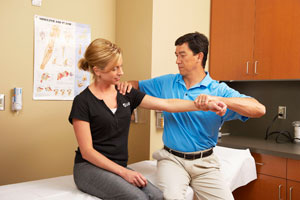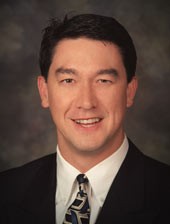Dr. Hwang received his Doctor of Medicine from the University of Minnesota Medical School. He completed his orthopedic residency as well as his sports medicine fellowship at Tulane University in New Orleans, and is certified by the American Board of Orthopaedic Surgery in Orthopaedic Surgery (2004) and Sports Medicine (2009). Dr. Hwang joined St. Cloud Orthopedics in July 2002 and is a member of American Academy of Orthopaedic Surgeons, Arthroscopy Association of North America, and American Orthopaedic Society of Sports Medicine.
Dr. Hwang has specialized training in the evaluation and arthroscopic treatment of knee, shoulder, elbow, and ankle disorders. He has a special interest in total shoulder and reverse shoulder replacement surgeries. In his practice, it has been apparent that many people are still unaware of the two different types of total shoulder replacements.
The anatomic total shoulder replacement replicates the normal anatomy of a patient and is primarily used for osteoarthritis. The reverse total shoulder replacement, reverses the patients bony anatomy and was designed to treat patients with shoulder arthritis due to rotator cuff tears.Because the reverse total shoulder arthroplasty has been such a success, the indications have been expanding to include complicated proximal humerus fractures, unrepairable massive rotator cuff repairs without arthritis, revision total shoulder arthroplasty, and total shoulder arthroplasty in patients with significant glenoid bone loss.
The main new technology in his practice has more to do with postoperative pain management after a shoulder surgery. In working with our local anesthesiologists at the St. Cloud Hospital and the St. Cloud Surgery Center, we have been able to implement an interscalene nerve block and an interscalene nerve pain pump. If successful, it can provide significant pain relief for up to 72 hours after any shoulder surgery.
The ideal candidate for a total shoulder replacement is a patient in their mid-60s or older with radiographic evidence of arthritis, who has pain that is no longer responding to conservative treatments such as medications or physical therapy.
The main benefit of a total shoulder replacement, reverse or anatomic, is pain relief. Up to 95% of patients will see significant pain improvement after a shoulder replacement. Secondary benefits usually include improvement of both range of motion and strength.
 Patients will usually require no more than an overnight stay after an uncomplicated total shoulder replacement. The patient, typically, will be in a sling for six weeks. They will receive physical therapy on postoperative day #1 at the hospital for a home exercise program. At two weeks they will have their first postoperative appointment with x-ray, after which, they will begin 10 weeks of formal physical therapy.
Patients will usually require no more than an overnight stay after an uncomplicated total shoulder replacement. The patient, typically, will be in a sling for six weeks. They will receive physical therapy on postoperative day #1 at the hospital for a home exercise program. At two weeks they will have their first postoperative appointment with x-ray, after which, they will begin 10 weeks of formal physical therapy.
Dr. Hwang estimates having performed 70 to 80 total shoulder replacements in 2014. He has performed approximately 300 shoulder replacements over the last five years. The breakdown between reverse and anatomic total shoulder replacements is roughly 50/50.
In Unites States, there were 53,000 total shoulder arthroplasties done in 2010.
The success rate for a total shoulder replacement is very good in relation to pain relief. Up to 95% of people see improvement of their pain. They also tend to see improvements in both range of motion and strength.
The biggest up and coming technology in shoulder replacements is going to be in patient specific guides. Similar to knee replacements, orthopedic implant manufacturers are now utilizing preoperative imaging, such as CT scans, to provide a one of a kind patient specific guides to help with placement of the glenoid cup or socket component.
Maybe the biggest tip to improve a patient’s preoperative symptoms has to do with range of motion of the shoulder. Through physical therapy, we can educate a patient on a range of motion program that, hopefully, will maximize the range of motion without aggravating their shoulder. This helps preoperatively by improving their function and also shortens their postoperative recovery.
Dr. Hwang is currently working with the St. Cloud Hospital System to put together a preoperative total shoulder arthroplasty preparation class. This will be available to patients that have an upcoming total shoulder replacement. This class will provide information about expectations, treatments for pain, and complication prevention. Nursing and physical therapy orthopedic specialists will be available for questions.

